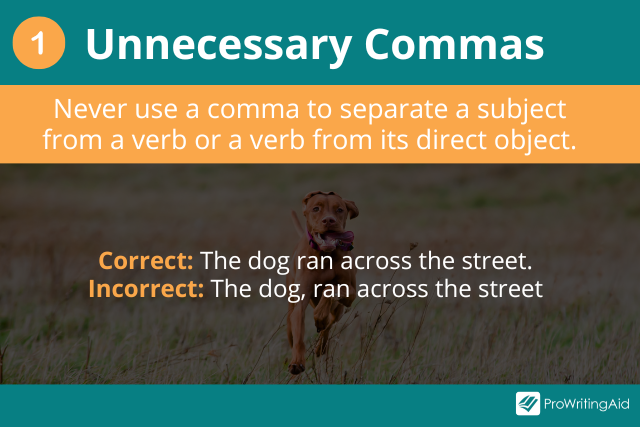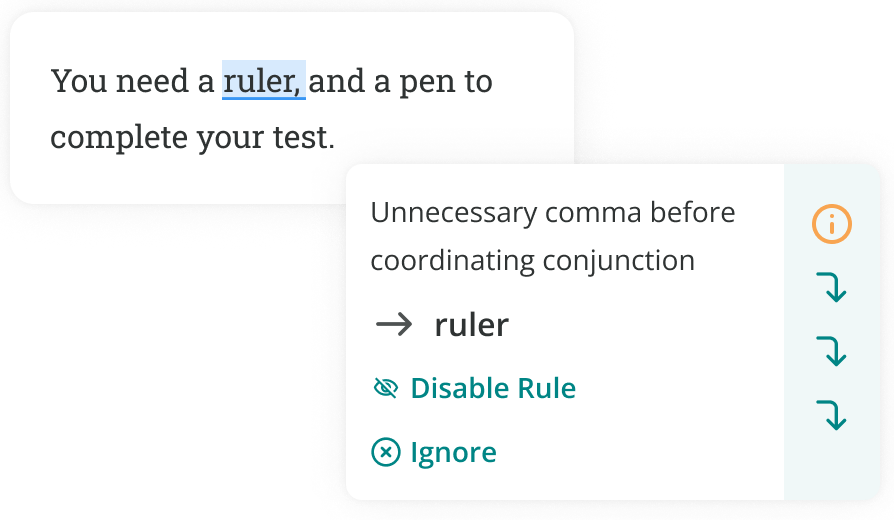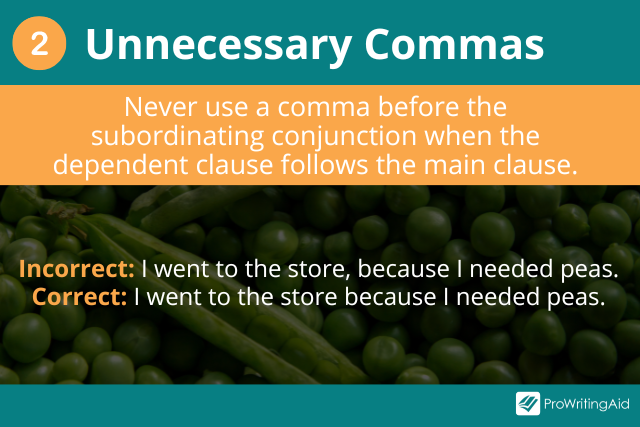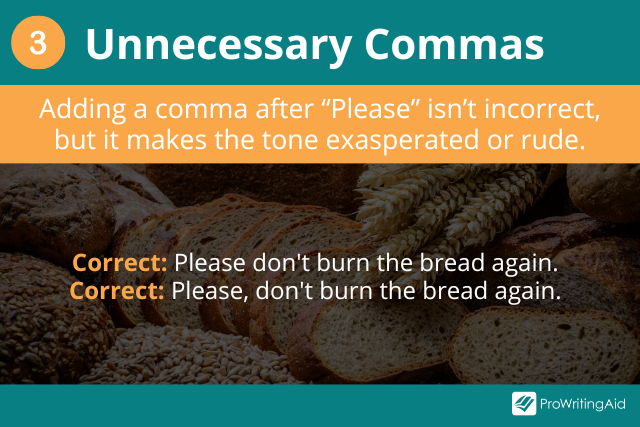
Commas are the most common punctuation mark, which means they have many tricky rules!
While there are plenty of rules about when you need a comma, there are also several rules about when you don’t need one.
Unnecessary commas will clutter up your writing and make your reader insert unnatural pauses. This affects the overall readability and clarity of your writing.
Let’s examine the primary rules regarding unnecessary commas.
Basic Rules About Unnecessary Commas
Two of the main comma rules involve subjects, objects, and verbs.
The first rule is to never separate a subject from its verb with a comma. You can see how the unnecessary comma creates an unnatural pause in the sentence’s flow.
Let’s look at an example:
Correct: The brown dog ran across the street.
Incorrect: The brown dog, ran across the street.

The second rule is to never separate a verb from its direct object with a comma. This also creates a strange pause.
Correct: He quickly grabbed the monkey bars.
Incorrect: He quickly grabbed, the monkey bars.
If you struggle with comma basics or more complex punctuation rules, you can use our free grammar checker. Keep your writing error-free with ProWritingAid.

Common Comma Mistakes with Clauses
Some of the most frequent comma usage errors involve joining clauses in sentences.
Before we dive into unnecessary commas in clauses, let’s review the difference between an independent and dependent clause.
Independent clauses are complete sentences on their own. They express a complete thought. Dependent clauses, also called subordinate clauses, cannot stand on their own as a sentence because they do not express a complete thought.
What’s a Comma Splice?
When we combine two independent clauses, we can do so in a few different ways.
We can use a comma plus a coordinating conjunction. We can use a semicolon or another punctuation mark like an em dash or colon. Or we can leave the two independent clauses as separate sentences.
A comma splice occurs when you combine two independent clauses with only a comma. This is grammatically incorrect.
Consider the example below:
Incorrect: I went to the movies, the seats were all sold out.
Correct: I went to the movies, but the seats were all sold out.
Correct: I went to the movies; the seats were all sold out.
Correct: I went to the movies. The seats were all sold out.
Never use just a comma to separate two independent clauses. The easiest way to fix a comma splice is by adding a coordinating conjunction. Doing so can also enhance the meaning of your sentence, like in the example above.
Should I Use a Comma Before a Dependent Clause?
While a coordinating conjunction connects independent clauses, subordinating conjunctions connect dependent, or subordinate, clauses.
Never use a comma before a subordinating conjunction when the dependent clause follows the main clause.
This means you will never use a comma before words like because, when, as, until, unless, or while.
Incorrect: I went to the store, because I needed milk.
Correct: I went to the store because I needed milk.
Here’s another example:
Incorrect: Let me know, when you get home.
Correct: Let me know when you get home.

Comma Errors and Introductory Words
Most introductory words require commas. This includes words like however, furthermore, next, and finally.
However, a comma is optional after the word then when it functions as an introductory word. It’s perfectly acceptable to leave the comma out or use a comma to add a distinct pause.
Correct: Then turn right by the oak tree.
Correct: Then, turn right by the oak tree.
Another introductory word with an optional comma is please. You should generally avoid using a comma after please at the beginning of a sentence.
But it’s not incorrect to place a comma after please. Be aware that adding a comma will change the tone of your sentence to exasperated, irritated, or rude because it adds a pause.
Correct: Please turn the water hose off when you’re finished.
Correct: Please, turn the water hose off when you’re finished.

Correlative Conjunctions and Commas
Some conjunctions come in pairs. We call these correlative conjunctions.
Some of the correlative conjunctions include:
- Both/and
- Either/or
- If/then
- Whether/or
- Neither/nor
- No sooner/than
You do not need a comma with a correlative conjunction in most cases.
Incorrect: Either we both go, or we stay home.
Correct: Either we both go or we stay home.
“If/then” is the exception to the rule. This pairing requires a comma before “then.”
Incorrect: If you miss your flight today then you’ll have to wait until tomorrow.
Correct: If you miss your flight today, then you’ll have to wait until tomorrow.
Is the Oxford Comma Necessary?
The Oxford comma is probably the most controversial punctuation in English, and it always comes up when discussing unnecessary commas.
Let’s have a quick refresher on the Oxford comma, also known as the serial comma.
The Oxford comma is the last comma in a list of three or more items. It comes before the words and or or, just after the second-to-last item in the list.
- I had a beef burrito, refried beans, and a Coke for dinner.
The comma after “refried beans” is an Oxford comma.
But this comma is still optional. Many people, especially older generations, learned to not put a comma here, like this:
- I had a beef burrito, refried beans and a Coke for dinner.
Although the Oxford comma is quickly becoming the standard, it’s not universal. Some people find it unnecessary.
Defer to your company, publication, or institution’s style guide when deciding whether or not to use an Oxford comma.
But if there’s no style guide, or you’re writing for yourself, it’s up to you. Just be consistent in your serial comma usage: don’t use it sometimes but not other times.
Conclusion on Unnecessary Commas
Unnecessary commas are just as distracting in your writing as missing commas. You can quickly increase your writing’s clarity and readability by following the rules above.
Still need help with commas? Check out our free comma splice checker.
